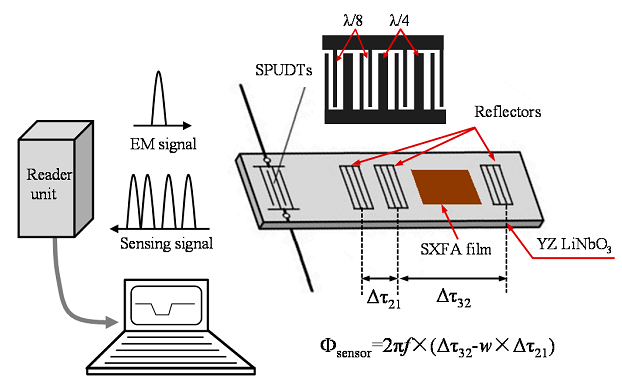Organophosphorous compounds, organic compounds containing phosphorus, are primarily used in pest control as an alternative to chlorinated hydrocarbons that persist in the environment. Organophosphorous chemistry is the corresponding science of the properties and reactivity of organophosphorous compounds.
Chemical sensors with high sensitivity and fast response for organophosphorous compound detection in real time are necessary for responding to the threats of terrorism and environmental pollution.
Among a wide range of available chemical sensors, surface acoustic wave (SAW)-based chemical sensors exhibit many unique advantages such as high sensitivity, ambient-temperature operation, fast response, low cost, easy reproducibility, and good stability.
A new robust wireless and passive SAW based chemical sensor for organophosphorous compound detection has been proposed recently by several researchers from Zhejiang University of Media and Communications, the Institute of Acoustics of the Chinese Academy of Sciences and the State Key Laboratory of NBC Protection for Civilian.
Since this new sensor is wireless and passive, it presents many advantages. The sensor chip is maintenance-free because it is passive, and does not require any power supply to operate. Also, the working environment can be very hazardous such as contaminated and high voltage areas because of the wireless measurement. Furthermore, temperature compensation can be accomplished well by using the sensor chip design through the differential method.
The schematic and working principle of the sensor are illustrated in Fig.1.

Fig. 1 Schematic and working principle of the proposed SAW chemical sensor (Image by the Institute of Acoustics of the Chinese Academy of Sciences)
The proposed sensor system is composed of a fluoroalcoholpolysiloxane-coated SAW reflective delay line, frequency-modulated continuous wave based reader unit, and the connected antennas.
The use of fluoroalcoholpolysiloxane is frequently reported for chemical interfaces for organophosphorous detection because of its low crystallinity and glass transition temperature, and high permeability. The SAW reflective delay line acts as the sensor chip, in which single phase unidirectional transducers and three shorted grating reflectors are placed in a row along the SAW propagation direction on an YZ LiNbO3 piezoelectric substrate.
Fluoroalcoholpolysiloxane film is coated onto the surface between the second and third reflectors of the SAW device for dimethylmethylphosphonate sensing. The first reflector of the SAW device is used for temperature compensation utilizing the difference method. When the single phase unidirectional transducers receive electromagnetic energy from the reader unit through the connected antenna, the SAW is generated by the single phase unidirectional transducers through the piezoelectric effect, and propagates towards the reflectors.
The propagating SAW is reflected partially from the reflectors, and reconverted into electromagnetic waves by the single phase unidirectional transducers and transmitted to the reader unit.
Besides, the adsorbed organophosphorouses in the fluoroalcoholpolysiloxane film modulate the SAW propagation, resulting in shifts in SAW velocity and attenuation, and changes in time delay of the reflection peaks from the reflectors.
Therefore, target organophosphorous concentrations can be extracted by evaluating the differential phase signals, Φsensor, as Φsensor = 2 × π× f × (∆τ32 - w ×∆τ21). The f is the operation sensor frequency, ∆τ32 and ∆τ21 are the measured changes in time delays among the three reflection peaks from the peaks, including the information of environmental temperature and target species concentration, and w is the ratio of the second-to-third reflector distance to the first-to-second reflector distance.
Prior to the sensor fabrication, the coupling of modes and perturbation theory are utilized to predict the SAW device performance and describe the gas adsorption of the sensor. And then, the developed SAW chemical sensor system is characterized wirelessly in dimethylmethylphosphonate gas experiments. The phase sensitivity, repeatability, and temperature compensation are investigated experimentally.
Reference:
XU Fangqian, WANG Wen, XUE Xufeng, HU Haoliang, LIU Xinlu, PAN Yong. Development of a Wireless and Passive SAW-Based Chemical Sensor for Organophosphorous Compound Detection. SENSORS (Vol. 15, No. 12, pp. 30187-30198, December 2015). DOI: 10.3390/s151229793
Contact:
WANG Wen
State Key Laboratory of Acoustics, Institute of Acoustics, Chinese Academy of Sciences, 100190 Beijing, China
Email: wangwenwq@mail.ioa.ac.cn


